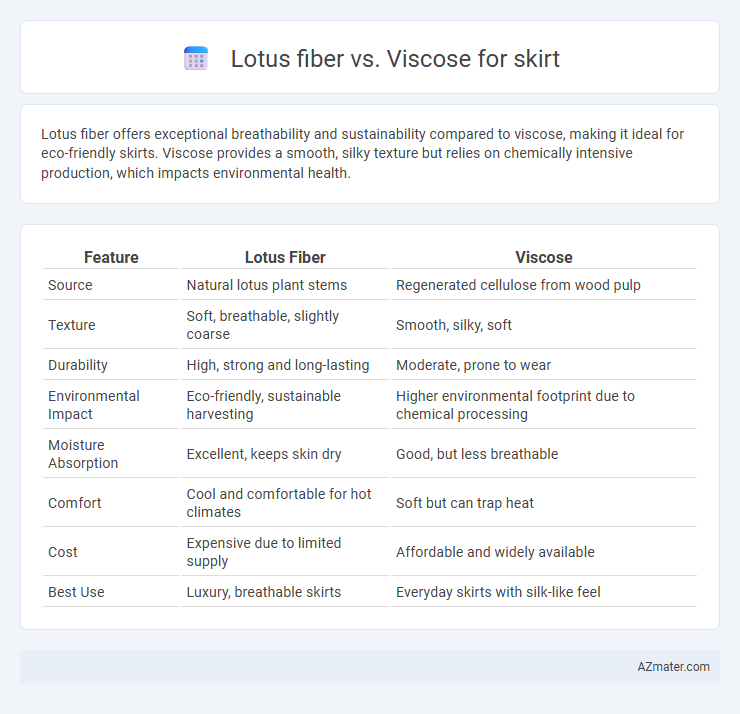Lotus fiber offers exceptional breathability and sustainability compared to viscose, making it ideal for eco-friendly skirts. Viscose provides a smooth, silky texture but relies on chemically intensive production, which impacts environmental health.
Table of Comparison
| Feature | Lotus Fiber | Viscose |
|---|---|---|
| Source | Natural lotus plant stems | Regenerated cellulose from wood pulp |
| Texture | Soft, breathable, slightly coarse | Smooth, silky, soft |
| Durability | High, strong and long-lasting | Moderate, prone to wear |
| Environmental Impact | Eco-friendly, sustainable harvesting | Higher environmental footprint due to chemical processing |
| Moisture Absorption | Excellent, keeps skin dry | Good, but less breathable |
| Comfort | Cool and comfortable for hot climates | Soft but can trap heat |
| Cost | Expensive due to limited supply | Affordable and widely available |
| Best Use | Luxury, breathable skirts | Everyday skirts with silk-like feel |
Introduction: Lotus Fiber vs Viscose for Skirts
Lotus fiber, derived from the lotus plant's stem, offers a sustainable and biodegradable alternative to viscose, which is typically made from chemically treated wood pulp. Skirts made from lotus fiber boast exceptional breathability, natural moisture-wicking properties, and a unique texture that enhances comfort and aesthetics. Viscose skirts, while soft and drapable, often involve energy-intensive production processes and the use of harmful chemicals, raising environmental concerns.
Origins and Production Processes
Lotus fiber is derived from the stems of the lotus plant, harvested primarily in Southeast Asia through a labor-intensive hand-extraction process that involves soaking, scraping, and spinning the fibers into thread. Viscose, on the other hand, is a semi-synthetic fiber made from chemically treated cellulose extracted mainly from wood pulp, undergoing processes such as steeping, pressing, shredding, and aging before being transformed into rayon fibers. The natural, sustainable origins and artisanal production of lotus fiber contrast sharply with the industrial, chemical-intensive manufacturing of viscose, affecting the environmental footprint and texture of the resulting fabric used in skirts.
Sustainability and Environmental Impact
Lotus fiber, derived from the stems of lotus plants, is highly sustainable due to its natural biodegradability and minimal water usage during production, making it an eco-friendly choice for skirts. In contrast, viscose, a semi-synthetic fiber produced from wood pulp, often involves chemical-intensive processes that contribute to deforestation and water pollution. Choosing lotus fiber for skirts significantly reduces environmental impact by supporting renewable resources and lower carbon emissions compared to viscose.
Texture and Comfort Comparison
Lotus fiber offers a naturally textured, breathable fabric known for its soft yet slightly coarse feel, making it ideal for skirts that require both durability and comfort in warm climates. Viscose, derived from cellulose, provides a smooth, silky texture with excellent drape, enhancing the skirt's comfort through its lightweight and moisture-absorbent qualities. When comparing texture and comfort, lotus fiber stands out for its eco-friendly breathability and unique tactile experience, while viscose excels in softness and fluid movement, catering to different wearer preferences.
Durability and Care Requirements
Lotus fiber offers superior durability compared to viscose, as it is derived from natural lotus stems known for their strength and resilience. Lotus fiber skirts require minimal care, often needing gentle hand washing and air drying to maintain texture and longevity, while viscose is prone to shrinkage and wrinkles, demanding careful machine washing or dry cleaning. Choosing lotus fiber ensures a longer-lasting, easy-to-maintain skirt with eco-friendly properties, whereas viscose skirts may wear out faster and require more delicate handling.
Color and Dye Affinity
Lotus fiber exhibits excellent natural dye affinity, absorbing colors deeply to produce vibrant, long-lasting hues with a soft, matte finish ideal for skirts. Viscose fibers absorb dye uniformly, resulting in bright and consistent colors, yet they may fade faster due to weaker fiber strength and higher moisture retention. Choosing lotus fiber ensures richer, more durable color saturation compared to viscose, important for maintaining skirt vibrancy over time.
Breathability and Moisture Management
Lotus fiber offers superior breathability compared to viscose, allowing better air circulation that keeps the skin cool and comfortable during wear. Its natural moisture-wicking properties efficiently absorb and release sweat, preventing dampness and promoting dryness throughout the day. Viscose tends to retain moisture longer, which can lead to a clammy feel and reduced comfort in warm or humid conditions.
Style and Aesthetic Appeal
Lotus fiber offers a unique, natural texture with a subtle sheen that enhances skirt designs, providing an eco-friendly and sophisticated alternative to viscose. Viscose produces a smooth, flowing drape that highlights vibrant colors and detailed prints, making it ideal for elegant and versatile skirt styles. Choosing between lotus fiber and viscose depends on the desired aesthetic, with lotus emphasizing organic, eco-luxurious appeal and viscose delivering polished, refined silhouettes.
Cost and Accessibility
Lotus fiber skirts are generally more expensive than viscose due to the labor-intensive extraction process and limited production, making them a luxury option for eco-conscious consumers. Viscose skirts tend to be more affordable and widely accessible, as viscose is mass-produced from wood pulp and readily available in various market segments. The cost disparity reflects lotus fiber's niche status and sustainable appeal compared to the commercial-scale production and availability of viscose fabrics.
Conclusion: Choosing the Right Fabric for Skirts
Lotus fiber offers exceptional breathability, sustainability, and a natural matte texture, making it ideal for eco-conscious consumers seeking unique, lightweight skirts. Viscose provides a smooth, silky feel with excellent drape and vibrant color options but involves more intensive chemical processing and less environmental friendliness. Selecting the right fabric depends on prioritizing environmental impact and natural texture with lotus fiber or opting for softness and variety with viscose for skirts.

Infographic: Lotus fiber vs Viscose for Skirt
 azmater.com
azmater.com